Spatial Heterogeneity of the Carbon Emission Effect Resulting from Urban Expansion among Three Coastal Agglomerations in China
Abstract
1. Introduction
2. Study Areas and Data Sources
3. Methods
3.1. Urban Information Extraction
3.2. Net Ecosystem Production (NEP) Calculation
3.3. Carbon Emission Calculation
3.4. Carbon Budgets Calculation
3.5. Spatial Statistics
4. Results
4.1. Urban Expansion Characteristics of the Three Urban Agglomerations
4.2. NEP and Carbon Emission Statistics for the Three Urban Agglomerations
4.3. Spatial Pattern of Carbon Source and Sink
5. Discussion
6. Conclusions
Author Contributions
Funding
Conflicts of Interest
References
- Luo, Y.; Weng, E. Dynamic disequilibrium of the terrestrial carbon cycle under global change. Trends Ecol. Evol. 2011, 26, 96–104. [Google Scholar] [CrossRef] [PubMed]
- Baldocchi, D.; Kelliher, F.M.; Black, T.A.; Jarvis, P. Climate and vegetation controls on boreal zone energy exchange. Glob. Chang. Biol. 2008, 6, 69–83. [Google Scholar] [CrossRef]
- Haverd, V.; Ahlström, A.; Smith, B.; Canadell, J.G. Carbon cycle responses of semi-arid ecosystems to positive asymmetry in rainfall. Glob. Chang. Biol. 2017, 23, 793–800. [Google Scholar] [CrossRef] [PubMed]
- Willeit, M.; Ganopolski, A.; Dalmonech, D.; Foley, A.M.; Feulner, G. Time-scale and state dependence of the carbon-cycle feedback to climate. Clim. Dyn. 2014, 42, 1699–1713. [Google Scholar] [CrossRef]
- Gao, X.; Schlosser, A.; Sokolov, A.P.; Anthony, K.W.; Zhuang, Q.L.; Kicklighter, D.W. Permafrost degradation and methane: Low risk of biogeochemical climate-warming feedback. Environ. Res. Lett. 2013, 8, 035014–035020. [Google Scholar] [CrossRef]
- Raupach, M.R.; Canadell, J.G.; Ciais, P.; Friedlingstein, P.; Rayner, P.J.; Trudinger, C.M. The relationship between peak warming and cumulative CO2 emissions, and its use to quantify vulnerabilities in the carbon-climate-human system. Tellus Ser. Bn Chem. Phys. Meteorol. 2011, 63, 145–164. [Google Scholar] [CrossRef]
- Alton, P.B. Reduced carbon sequestration in terrestrial ecosystems under overcast skies compared to clear skies. Agric. For. Meteorol. 2008, 148, 1641–1653. [Google Scholar] [CrossRef]
- Miles, L.; Kapos, V. Reducing greenhouse gas emissions from deforestation and forest degradation: Global land-use implications. Science 2008, 320, 1454–1455. [Google Scholar] [CrossRef] [PubMed]
- Morita, M. Quantification of increased flood risk due to global climate change for urban river management planning. Water Sci. Technol. J. Int. Assoc. Water Pollut. Res. 2011, 63, 2967–2974. [Google Scholar] [CrossRef]
- Alam, A. Nuclear energy, CO2 emissions and economic growth: The case of developing and developed countries. J. Econ. Stud. 2013, 40, 822–834. [Google Scholar] [CrossRef]
- Shahbaz, M.; Hye, Q.M.A.; Tiwari, A.; Leitao, N.C. Economic growth, energy consumption, financial development, international trade and CO2 emissions in Indonesia. Renew. Sustain. Energy Rev. 2013, 25, 109–121. [Google Scholar] [CrossRef]
- Grimm, N.B.; Faeth, S.H.; Golubiewski, N.E.; Redman, C.L.; Wu, J.G.; Bai, X.M.; Briggs, J.M. Global change and the ecology of cities. Science 2008, 319, 756–760. [Google Scholar] [CrossRef] [PubMed]
- Zhang, W.T.; Huang, B.; Luo, D. Effects of land use and transportation on carbon sources and carbon sinks: A case study in Shenzhen, China. Landsc. Urban Plan. 2014, 122, 175–185. [Google Scholar] [CrossRef]
- Pan, A. Foreign Trade, Interregional Trade and Carbon Emissions Transfer: Analysis Based on China’ Regional Input output Tables. J. Financ. Econ. 2017, 43, 57–69. [Google Scholar]
- Wang, Z.F.; Chen, P. Unbalanced Economic Development and Coordinated Development of Eastern and Western China. J. Jishou Univ. 2010, 31, 111–115. [Google Scholar]
- Wu, X.Y. An Empirical Study on the Unbalance Development of China’s Insurance Industry across Provinces: 1997–2007. J. Quant. Tech. Econ. 2009, 6, 99–114. [Google Scholar]
- Shen, L.; Sun, Y.Z. Review on carbon emissions, energy consumption and low-carbon economy in China from a perspective of global climate change. J. Geogr. Sci. 2016, 26, 855–870. [Google Scholar] [CrossRef]
- Chuai, X.W.; Huang, X.J.; Zhang, M.; Lu, Q.L.; Zhao, R.Q.; Lu, J.Y. Spatiotemporal Changes of Built-Up Land Expansion and Carbon Emissions Caused by the Chinese Construction Industry. Environ. Sci. Technol. 2015, 49, 13021–13030. [Google Scholar] [CrossRef]
- Chen, B.; Yang, S.; Xu, X.D.; Zhang, W. The impacts of urbanization on air quality over the Pearl River Delta in winter: Roles of urban land use and emission distribution. Theor. Appl. Climatol. 2014, 117, 29–39. [Google Scholar] [CrossRef]
- Diao, Y.W.; Huang, J.P.; Liu, C.; Cui, J.; Liu, S.D. A Modeling Study of CO_2 Flux and Concentrations over the Yangtze River Delta Using the WRF-GHG Model. Chin. J. Atmos. Sci. 2015, 39, 849–860. [Google Scholar]
- Wang, H.; Chen, C.C.; Pan, T.; Liu, C.L.; Chen, L.; Sun, L. County scale characteristics of CO2 emission’s spatial-temporal evolution in the Beijing-Tianjin-Hebei Metropolitan Region. Huan Jing Ke Xue 2014, 35, 385–393. [Google Scholar]
- Zha, D.L.; Zhou, D.Q.; Zhou, P. Driving forces of residential CO2 emissions in urban and rural China: An index decomposition analysis. Energy Policy 2010, 38, 3377–3383. [Google Scholar]
- Sun, L.Y.; Li, L.; Chen, Z.Z.; Wang, J.Y.; Xiong, Z.Q. Combined effects of nitrogen deposition and biochar application on emissions of N2O, CO2 and NH3 from agricultural and forest soils. Soil Sci. Pl. Nutr. 2014, 60, 254–265. [Google Scholar] [CrossRef]
- Haas, J.; Ban, Y. Urban growth and environmental impacts in Jing-Jin-Ji, the Yangtze, River Delta and the Pearl River Delta. Int. J. Appl. Earth Obs. Geoinform. 2014, 30, 42–55. [Google Scholar] [CrossRef]
- Xie, H.; Wang, W. Spatiotemporal differences and convergence of urban industrial land use efficiency for China’s major economic zones. J. Geogr. Sci. 2015, 25, 1183–1198. [Google Scholar] [CrossRef]
- Li, J.; Wang, Z.L.; Lai, C.G.; Wu, X.Q.; Zeng, Z.Y.; Chen, X.H.; Lian, Y.Q. Response of net primary production to land use and land cover change in mainland China since the late 1980s. Sci. Total Environ. 2018, 639, 237–247. [Google Scholar] [CrossRef]
- He, L.Y.; Huang, X.F.; Xue, L.; Hu, M.; Lin, Y.; Zheng, J.; Zhang, R.Y.; Zhang, Y.H. Submicron aerosol analysis and organic source apportionment in an urban atmosphere in Pearl River Delta of China using high-resolution aerosol mass spectrometry. J. Geophys. Res. Atmos. 2011, 116. [Google Scholar] [CrossRef]
- Tian, Z.H.; Liu, R.H. Inter-annual Variations of the Carbon Footprint in Beijing Tianjin and Hebei Agro-ecosystem. J. Agric. Resour. Environ. 2018, 35, 167–173. [Google Scholar]
- Yi, B.L.; Han, J.; Zhou, X.; Yang, F.; Meng, X.; Cao, W.X.; Huang, L.X.; Xiang, W.N. Spatiotemporal pattern of carbon sources and sinks in Yangtze River Delta region, China. Chin. J. Appl. Ecol. 2015, 26, 973–980. [Google Scholar]
- Morton, P.A.; Andreas, H. Vegetation matters: Correcting chamber carbon flux measurements using plant volumes. Sci. Total Environ. 2018, 639, 769–772. [Google Scholar] [CrossRef]
- Amiro, B.D.; Tenuta, M.; Gervais, M.; Glenn, A.J.; Gao, X. A decade of carbon flux measurements with annual and perennial crop rotations on the Canadian Prairies. Agric. For. Meteorol. 2017, 247, 491–502. [Google Scholar] [CrossRef]
- Ng, B.; Hutyra, L.R.; Nguyen, H.T.; Cobb, A.R.; Kai, F.M.; Harvey, C.F.; Gandois, L. Carbon fluxes from an urban tropical grassland. Environ. Pollut. 2015, 203, 227–234. [Google Scholar] [CrossRef]
- Rahman, M.M.; Kashem, M.A. Carbon emissions, energy consumption and industrial growth in Bangladesh: Empirical evidence from ARDL cointegration and Granger causality analysis. Energy Policy 2017, 110, 600–608. [Google Scholar] [CrossRef]
- Cao, Q.R.; Kang, W.; Sajid, M.J.; Cao, M. Measuring China’s carbon emissions based on final consumption. Energy Procedia 2018, 152, 853–862. [Google Scholar] [CrossRef]
- Chuai, X.; Qi, X.; Zhang, X.; Li, J.; Yuan, Y.; Guo, X.; Huang, X.; Park, S.; Zhao, R.; Xie, X.; et al. Land degradation monitoring using terrestrial ecosystem carbon sinks/sources and their response to climate change in China. Land Degrad. Dev. 2018, 29, 3489–3502. [Google Scholar] [CrossRef]
- Abdalla; Fadul, R.A. Assessment and Mapping of Urban Forest Cover and Carbon Emission in Khartoum Locality Using Remote Sensing and GIS. Available online: http://khartoumspace.uofk.edu/handle/123456789/20912 (accessed on 1 May 2016).
- Meng, L.; Crijns, W.H.; Worrell, E.; Huang, B. Estimating CO2 emissions at urban scales by DMSP/OLS nighttime light imagery: Methodological challenges and a case study for China. Energy 2014, 71, 468–478. [Google Scholar] [CrossRef]
- Zhang, Y.J.; Yu, G.R.; Yang, J.; Wimberly, M.C.; Zhang, X.Z.; Tao, J.; Jiang, Y.B.; Zhu, J.T. Climate-driven global changes in carbon use efficiency. Glob. Ecol. Biogeogr. 2014, 23, 144–155. [Google Scholar] [CrossRef]
- Heinsch, F.A.; Zhao, M.S.; Running, W.R.; Kimball, J.S.; Nemani, R.R.; Davis, K.J.; Bolstad, P.V.; Cook, B.D.; Desai, A.R.; Ricciuto, D.M.; et al. Evaluation of Remote Sensing Based Terrestrial Productivity From MODIS Using Regional Tower Eddy Flux Network Observations. IEEE Trans. Geosci. Remote Sens. 2006, 44, 1908–1925. [Google Scholar] [CrossRef]
- Cao, Z.Y. Estimating the Spatial Distribution of GDP Based on Nighttime Light Image and Analysis of Correlation Between It and PM2.5 Concentration; Guangzhou Institute of Geochemistry, CAS: Guangzhou, China, 2016. [Google Scholar]
- Liu, Z.F.; He, C.Y.; Zhang, Q.F.; Huang, Q.X.; Yang, Y. Extracting the dynamics of urban expansion in China using DMSP-OLS nighttime light data from 1992 to 2008. Landsc. Urban Plan. 2012, 106, 62–72. [Google Scholar] [CrossRef]
- Li, Z.A.; Kurz, W.; Banfield, E. Temporal changes of forest net primary production and net ecosystem production in west central Canada associated with natural and anthropogenic disturbances. Can. J. For. Res. 2003, 33, 2340–2351. [Google Scholar] [CrossRef]
- Yu, G.; Zheng, Z.; Wang, Q.; Fu, Y.; Zhuang, J.; Sun, X. Spatiotemporal pattern of soil respiration of terrestrial ecosystems in China: the development of a geostatistical model and its simulation. Environ. Sci. Technol. 2010, 44, 6074–6080. [Google Scholar] [CrossRef]
- Shao, L.; Chen, G.Q.; Chen, Z.M.; Guo, S.; Han, M.Y.; Zhang, B.; Hayat, T.; Alsaedi, A.; Ahmad, B. Systems accounting for energy consumption and carbon emission by building. Commun. Nonlinear Sci. Numer. Simul. 2014, 19, 1859–1873. [Google Scholar] [CrossRef]
- Shahzad, J.; Kumar, R.R.; Zakaria, M.; Hurr, M. Carbon emission, energy consumption, trade openness and financial development in Pakistan: A revisit. Renew. Sustain. Energy Rev. 2017, 70, 185–192. [Google Scholar] [CrossRef]
- Letu, H.; Hara, M.; Yagi, H.; Tana, G.; Nishio, F. Estimating the energy consumption with nighttime city light from the DMSP/OLS imagery. In Proceedings of the Urban Remote Sensing Joint Event, Shanghai, China, 20–22 May 2009. [Google Scholar] [CrossRef]
- Wu, J.S.; Niu, Y.; Peng, J.; Wang, Z.; Huang, X.L. Research on energy consumption dynamic among prefecture-level cities in China based on DMSP/OLS Nighttime Light. Geogr. Res. 2014, 33, 625–634. [Google Scholar]
- Xie, Y.; Weng, Q. World energy consumption pattern as revealed by DMSP-OLS nighttime light imagery. Mapp. Sci. Remote Sens. 2016, 53, 265–282. [Google Scholar] [CrossRef]
- Mitchell, A. The ESRI Guide to GIS Analysis; ESRI Pres: Redlands, CA, USA, 2005; Volume 2. [Google Scholar]
- Thompson, E.S.; Saveyn, P.; Declercq, M.; Meert, J.; Guida, V.; Eads, C.; Robles, E.; Britton, M.M. Characterisation of heterogeneity and spatial autocorrelation in phase separating mixtures using Moran’s I. J. Coll. Interface Sci. 2018, 513, 180–187. [Google Scholar] [CrossRef]
- Tyralis, H.; Mamassis, N.; Photis, Y.N. Spatial Analysis of Electricity Demand Patterns in Greece: Application of a GIS-based Methodological Framework. Energy Procedia 2016, 97, 262–269. [Google Scholar] [CrossRef][Green Version]
- Vessella, F.; Salis, A.; Scirè, M.; Piovesan, G.; Schirone, B. Natural regeneration and gender-specific spatial pattern of Taxus baccata in an old-growth population in Foresta Umbra (Italy). Dendrobiology 2015, 73, 75–90. [Google Scholar] [CrossRef]
- Liao, H.; Cao, H.S. How does carbon dioxide emission change with the economic development? Statistical experiences from 132 countries. Glob. Environ. Chang. 2013, 23, 1073–1082. [Google Scholar] [CrossRef]
- Grant, R.F.; Baldocchi, D.; Ma, S. Ecological controls on net ecosystem productivity of a seasonally dry annual grassland under current and future climates: Modelling with ecosys. Agric. For. Meteorol. 2012, 152, 189–200. [Google Scholar] [CrossRef]
- Price, J.; Quaife, T.; Woodward, I. Using MODIS Vegetation Index Data to Test Land Cover Parameterisation in a Global Vegetation Model Across Europe. In Proceedings of the EGU General Assembly, Vienna, Austria, 7–12 April 2013. [Google Scholar]
- Cai, H.Y.; Di, X.Y.; Chang, S.X.; Wang, C.K.; Shi, B.K.; Geng, P.F.; Jin, G.Z. Carbon storage, net primary production, and net ecosystem production in four major temperate forest types in northeastern China. Can. J. For. Res. 2015, 46, 620–623. [Google Scholar] [CrossRef]
- Chang, C.C. A multivariate causality test of carbon dioxide emissions, energy consumption and economic growth in China. Appl. Energy 2010, 87, 3533–3537. [Google Scholar] [CrossRef]
- Randerson, J.T.; Chapin, F.S.; Harden, J.W.; Neff, J.C.; Harmon, M.E. Net Ecosystem Production: A Comprehensive Measure of Net Carbon Accumulation by Ecosystems. Ecol. Appl. 2002, 12, 937–947. [Google Scholar] [CrossRef]
- Zhang, L.; Guo, H.D.; Jia, G.; Wylie, B.; Gilmanov, T.; Howard, D.; Ji, L.; Xiao, J.F.; Yuan, W.P.; Zhao, T.B.; et al. Net ecosystem productivity of temperate grasslands in northern China: An upscaling study. Agric. For. Meteorol. 2014, 184, 71–81. [Google Scholar] [CrossRef]
- Guo, Z.C.; Fu, Z.X. Current situation of energy consumption and measures taken for energy saving in the iron and steel industry in China. Energy 2010, 35, 4356–4360. [Google Scholar] [CrossRef]
- Duan, W.J.; Lang, J.L.; Cheng, S.Y.; Jia, J.; Wang, X.Q. Air Pollutant Emission Inventory from Iron and Steel Industry in the Beijing-Tianjin-Hebei Region and Its Impact on PM (2.5). Environ. Sci. 2018, 39, 1445–1454. [Google Scholar]
- Tao, Y.; Zhang, S.L. Environmental efficiency of electric power industry in the Yangtze River Delta. Math. Comput. Model. 2013, 58, 927–935. [Google Scholar] [CrossRef]
- Zheng, Y.B.; Gu, Y.R.; Zhang, M.; Wang, K.; Huang, Z.L.; Lin, C.S.; Gao, Z.L. Health care workers in Pearl River Delta Area of China are not vaccinated adequately against hepatitis B: A retrospective cohort study. BMC Infect. Dis. 2015, 15, 542–548. [Google Scholar] [CrossRef]
- Han, J.; Meng, X.; Zhou, X.; Yi, B.L.; Liu, M.; Xiang, W.N. A long-term analysis of urbanization process, landscape change, and carbon sources and sinks: A case study in China’s Yangtze River Delta region. J. Clean. Prod. 2017, 141, 1040–1050. [Google Scholar] [CrossRef]
- Gu, C.L.; Hu, L.Q.; Zhang, X.M.; Wang, X.D.; Guo, J. Climate change and urbanization in the Yangtze River Delta. Habitat Int. 2011, 35, 544–552. [Google Scholar] [CrossRef]
- Chen, M.X.; Gong, Y.H.; Lu, D.D.; Ye, C. Build a people-oriented urbanization: China’s new-type urbanization dream and Anhui model. Land Use Policy 2019, 80, 1–9. [Google Scholar] [CrossRef]
- Zhang, Y.H.; Hu, T.; Zhong, L.J.; Wiedensohler, A.; Liu, S.C.; Andreae, M.O.; Wang, W.Z.; Fan, S.J. Regional integrated experiments on air quality over Pearl River Delta 2004 (PRIDE-PRD2004): Overview. Atmos. Environ. 2008, 42, 6157–6173. [Google Scholar] [CrossRef]
- He, S.J.; Liu, Z. A follow-on study on the impact of urban redevelopment on local residents induced by the Asian Games: An investigation in three affected communities in Guangzhou. Geogr. Res. 2013, 32, 1046–1056. [Google Scholar]
- Yue, W.; Liu, Y.; Fan, P. Measuring urban sprawl and its drivers in large Chinese cities: The case of Hangzhou. Land Use Policy 2013, 31, 358–370. [Google Scholar] [CrossRef]
- Li, Y.; He, C.F. Characteristics and mechanism of manufacturing industry shift in the Pearl River Delta during 1998–2009. Progress Geogr. 2013, 32, 777–787. [Google Scholar]
- Liu, Z.J.; Huang, H.Q.; Werners, S.E.; Yan, D. Construction area expansion in relation to economic-demographic development and land resource in the Pearl River Delta of China. J. Geogr. Sci. 2016, 26, 188–202. [Google Scholar] [CrossRef]
- Zhang, D.J.; Liu, K.W.; Chen, Z.N.; Wang, L.B. The Ubuffer Spatial Analysis on Economic Growth of the Pearl River Delta Urban Agglomerations Based on UGIS. Progress Geogr. 2009, 28, 259–263. [Google Scholar]
- Wang, T.Y.; Luo, S.M. Tourism Resources in West and East Guangdong and Their Exploitation. Trop. Geogr. 2007, 27, 76–80. [Google Scholar]
- Zhu, F.B.; Lu, L. Spatial Tourism Equilibrium Development in the Pearl River Delta Metropolitan Area. J. Nat. Resour. 2010, 25, 1565–1576. [Google Scholar]
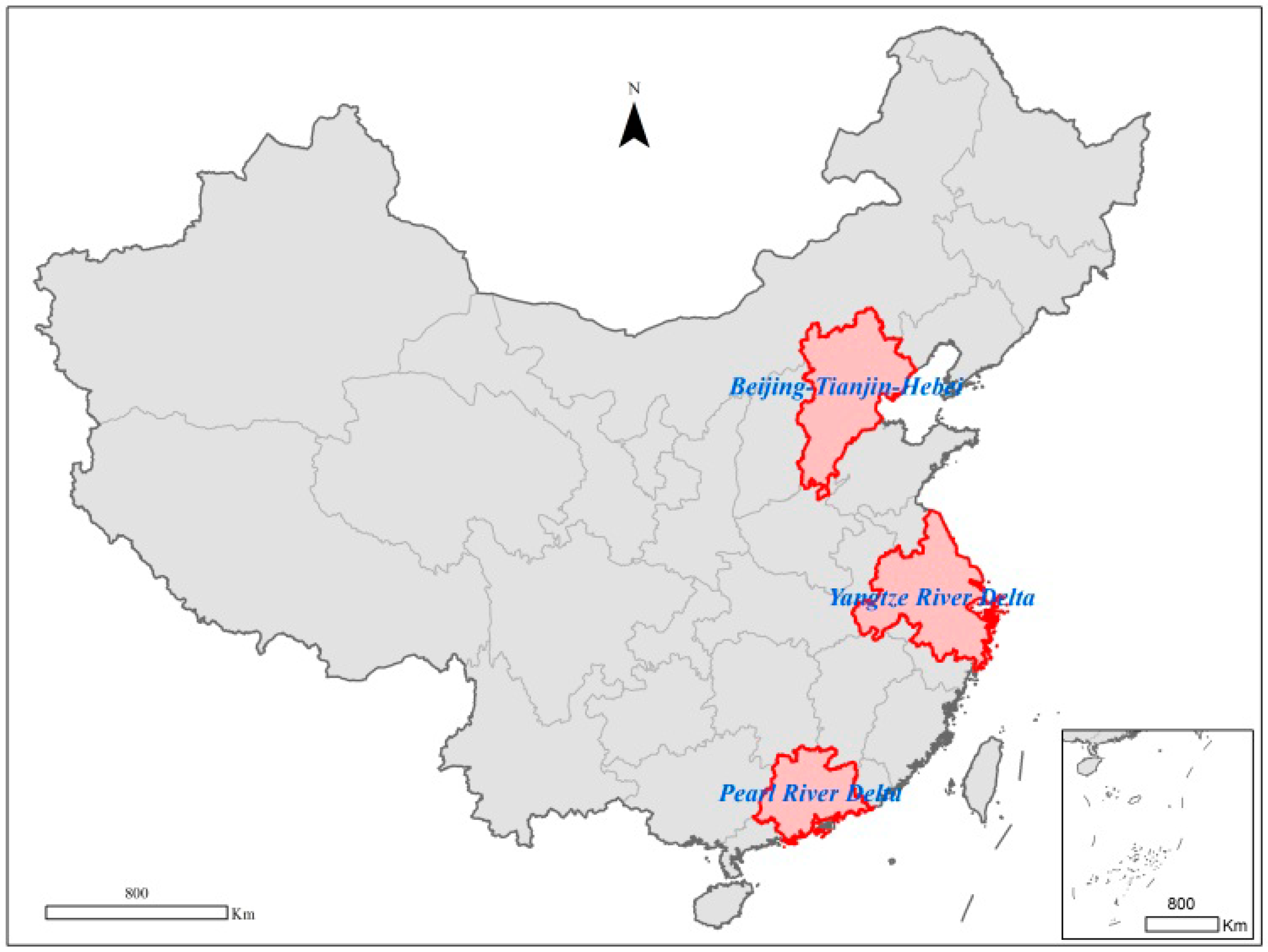
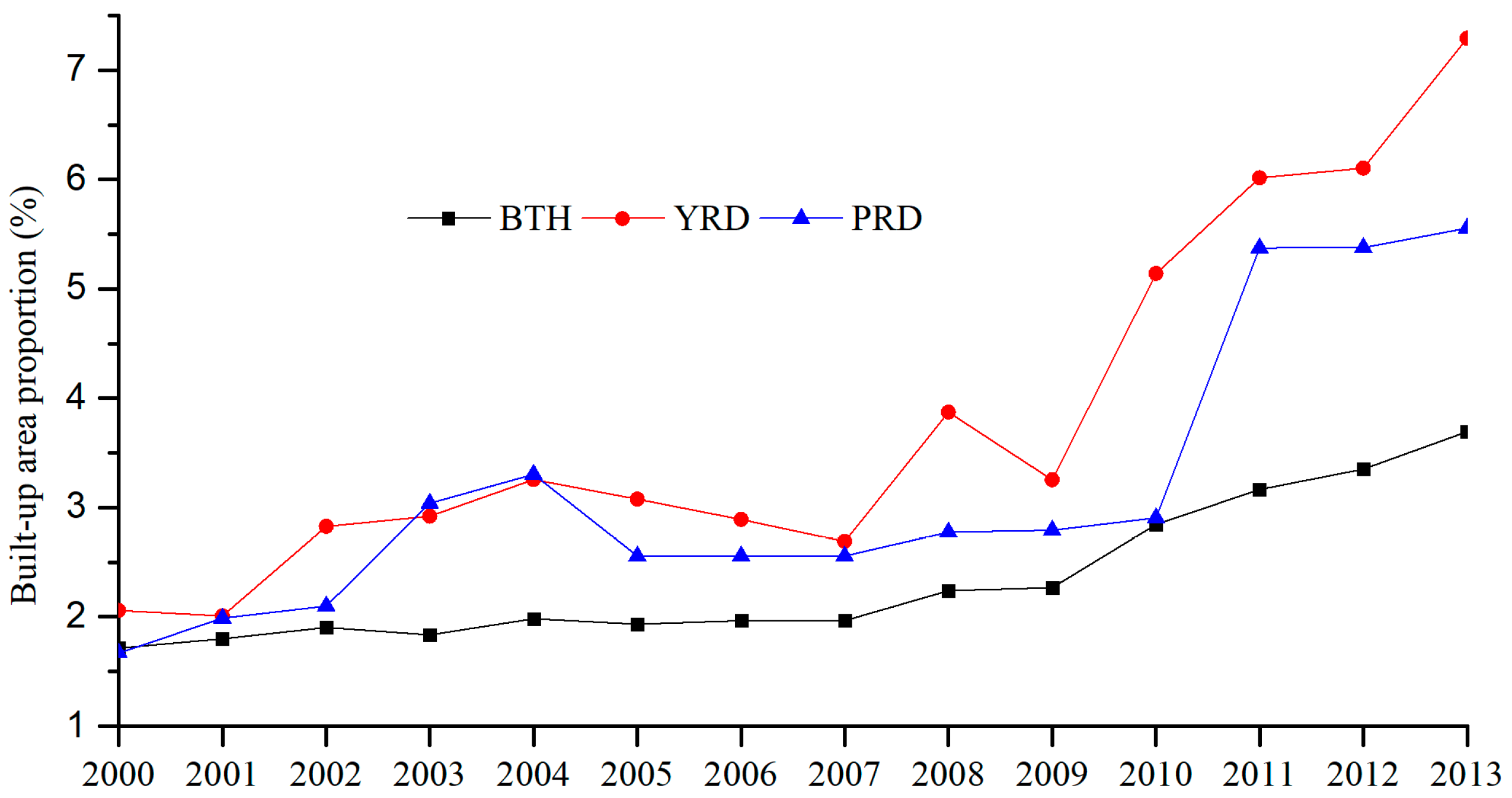
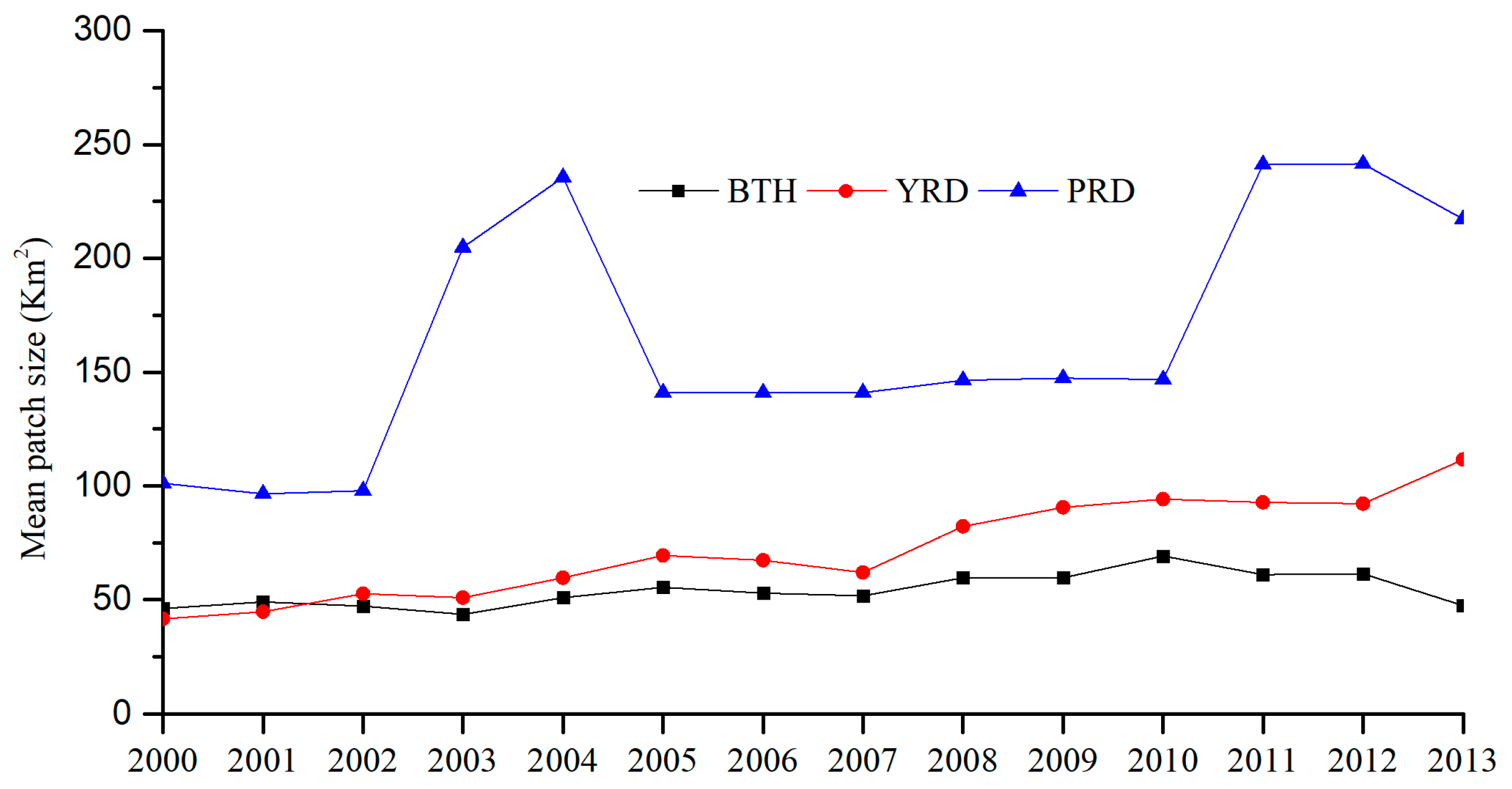
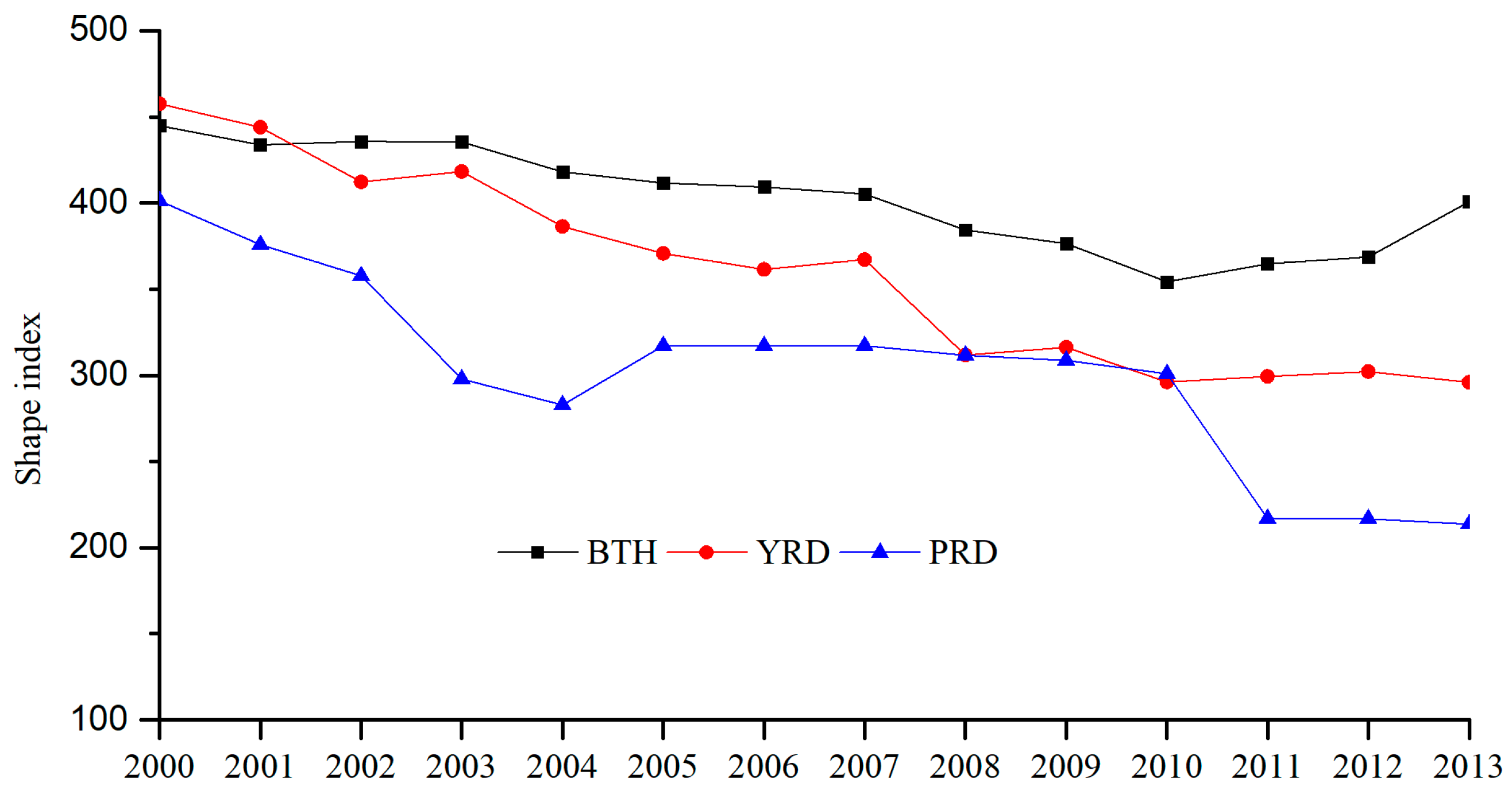
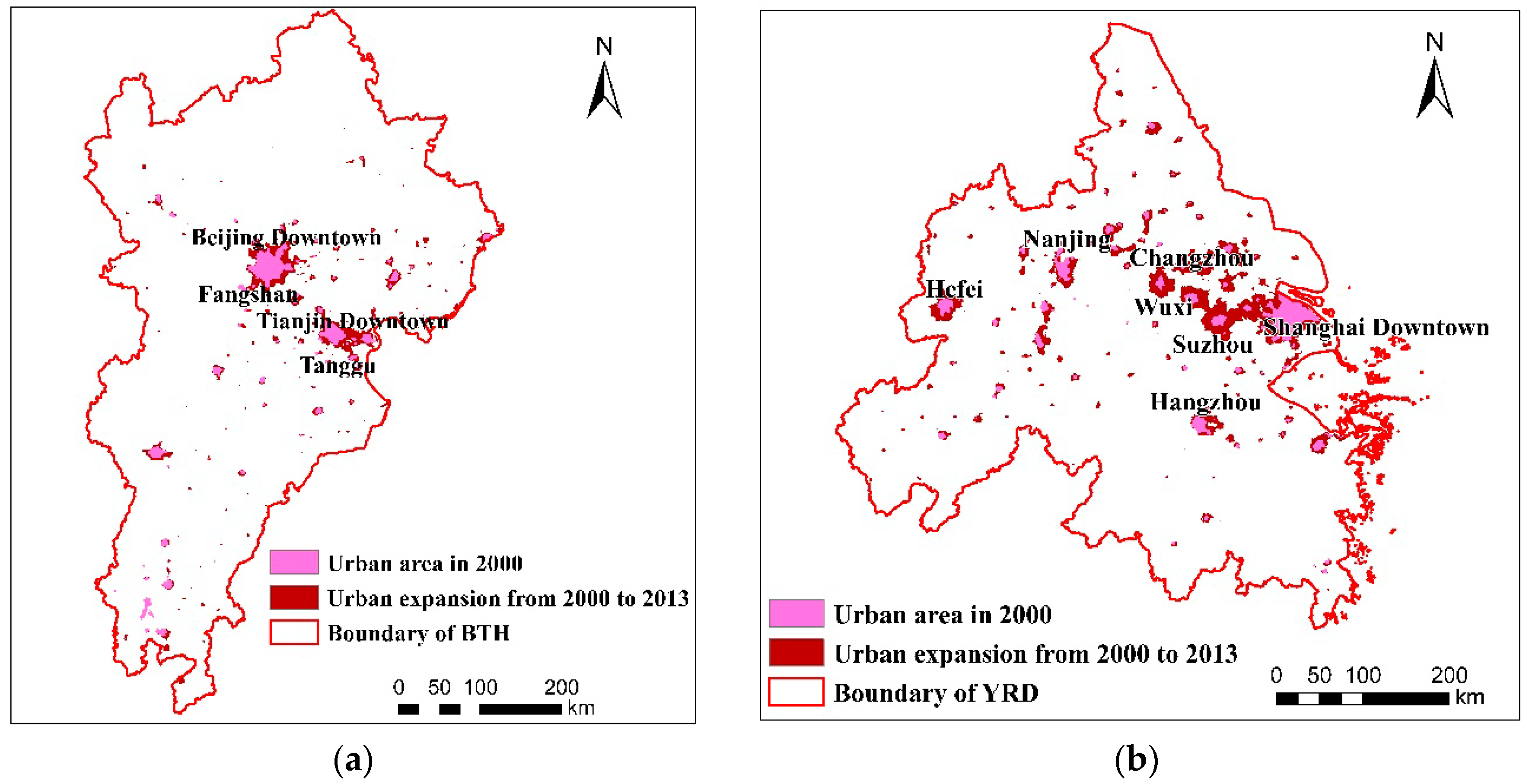
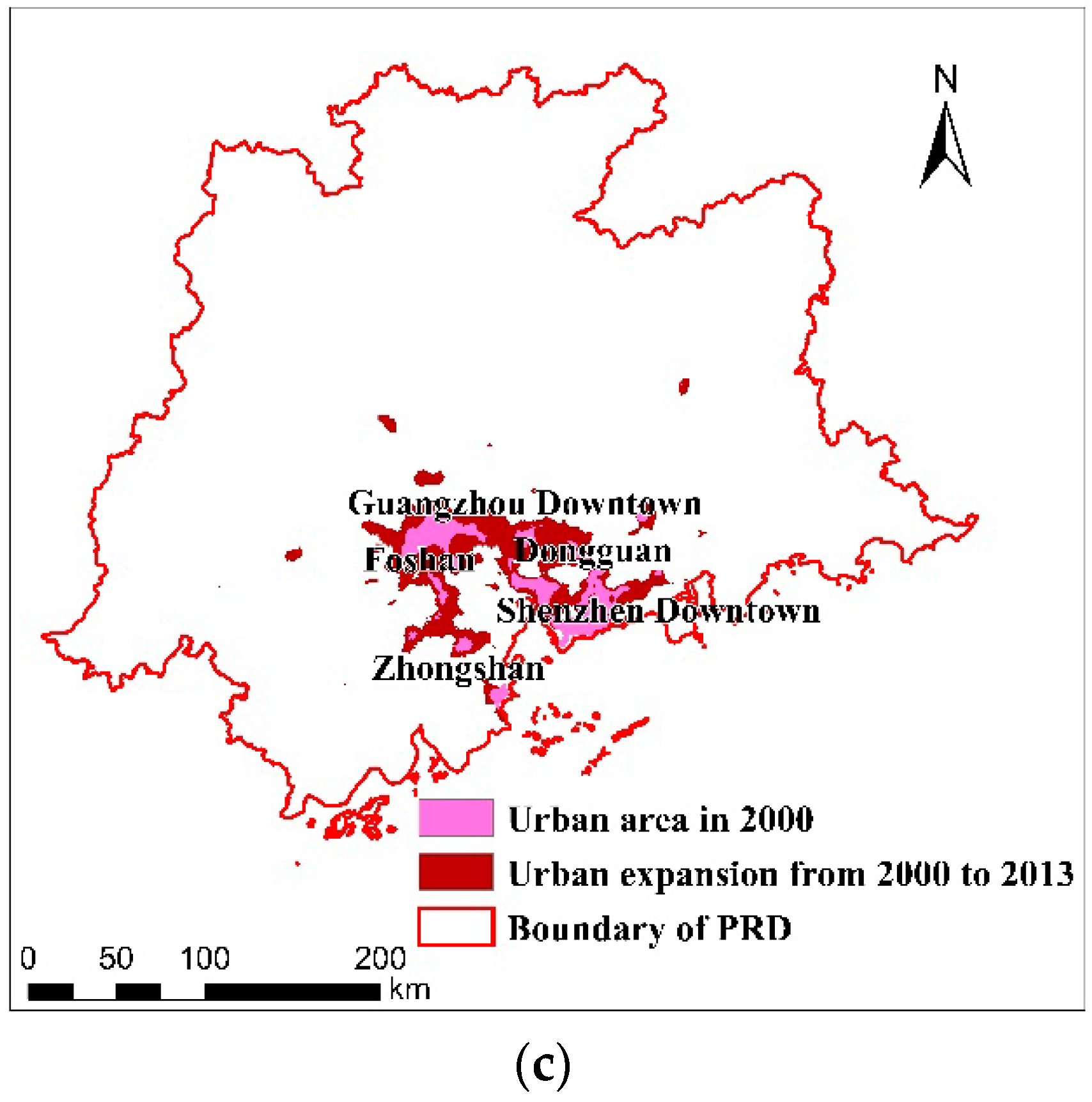

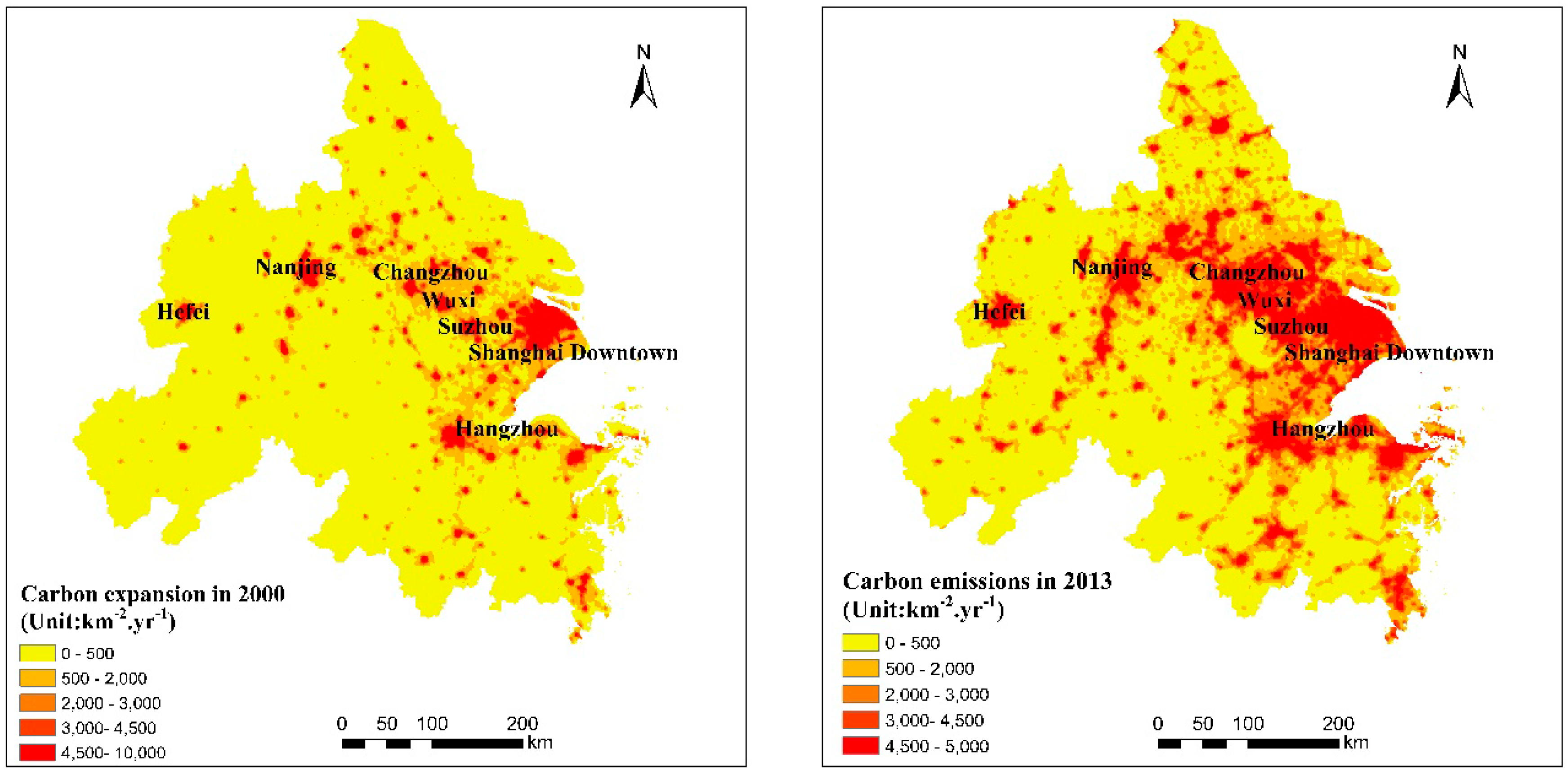
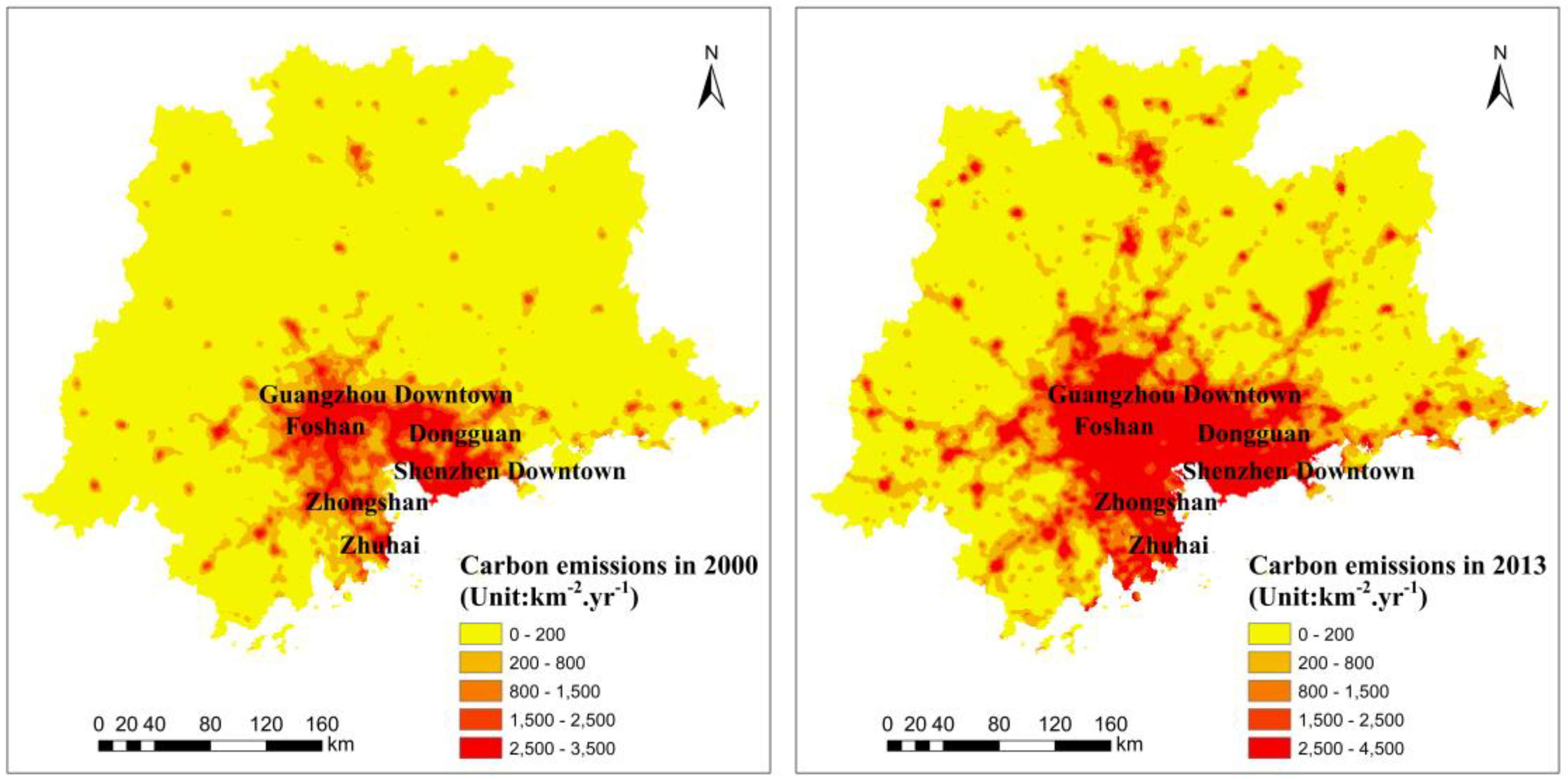
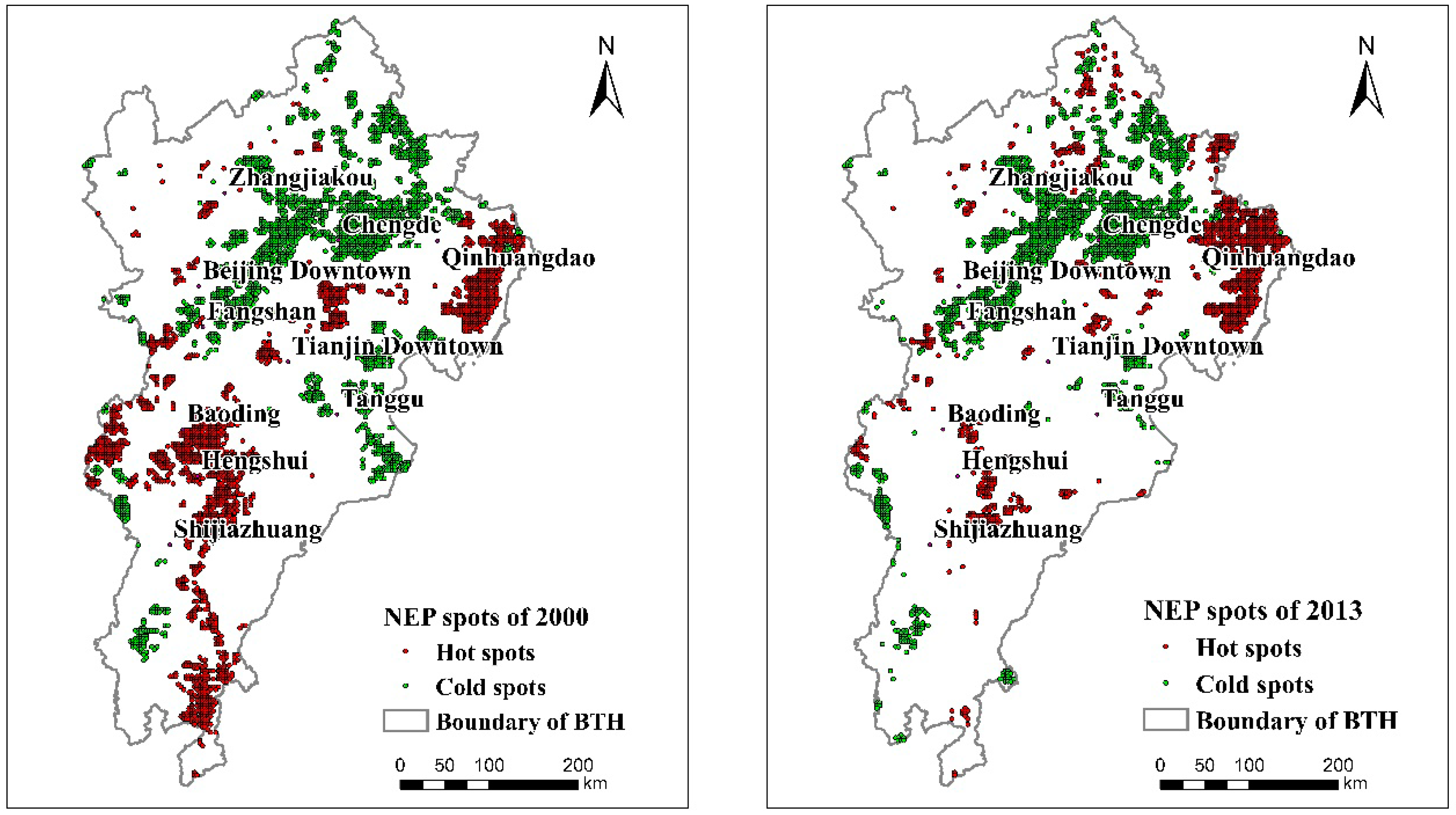
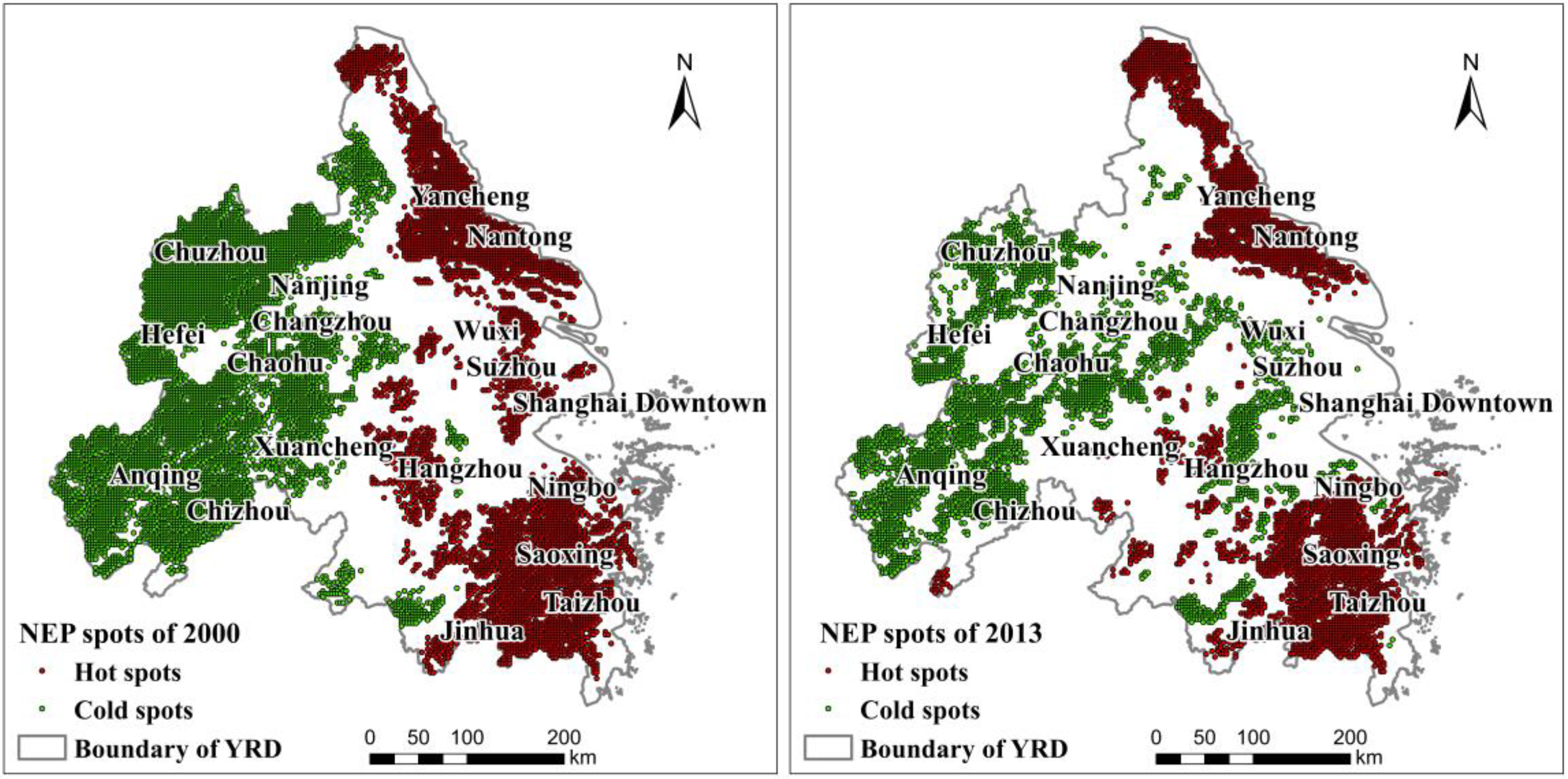
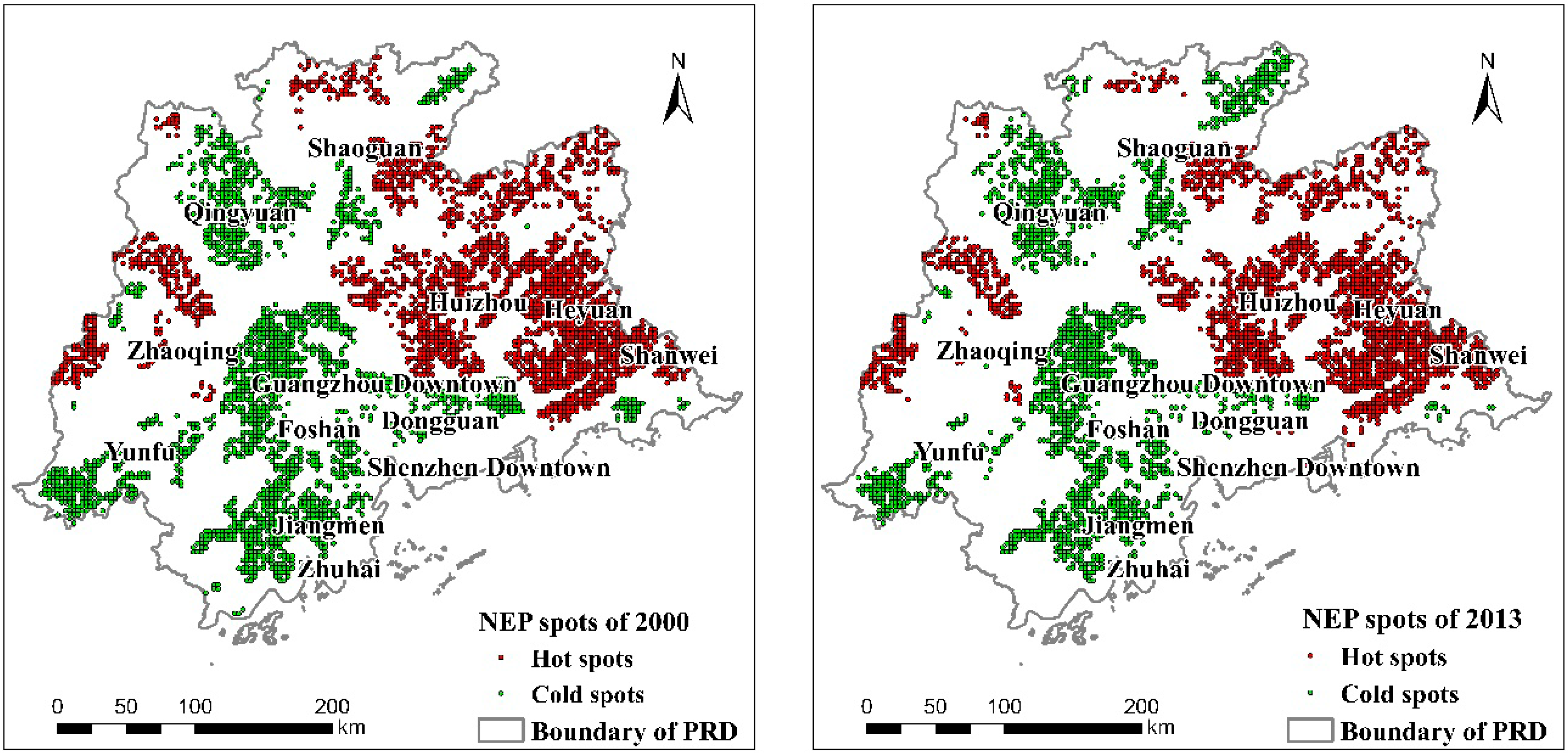
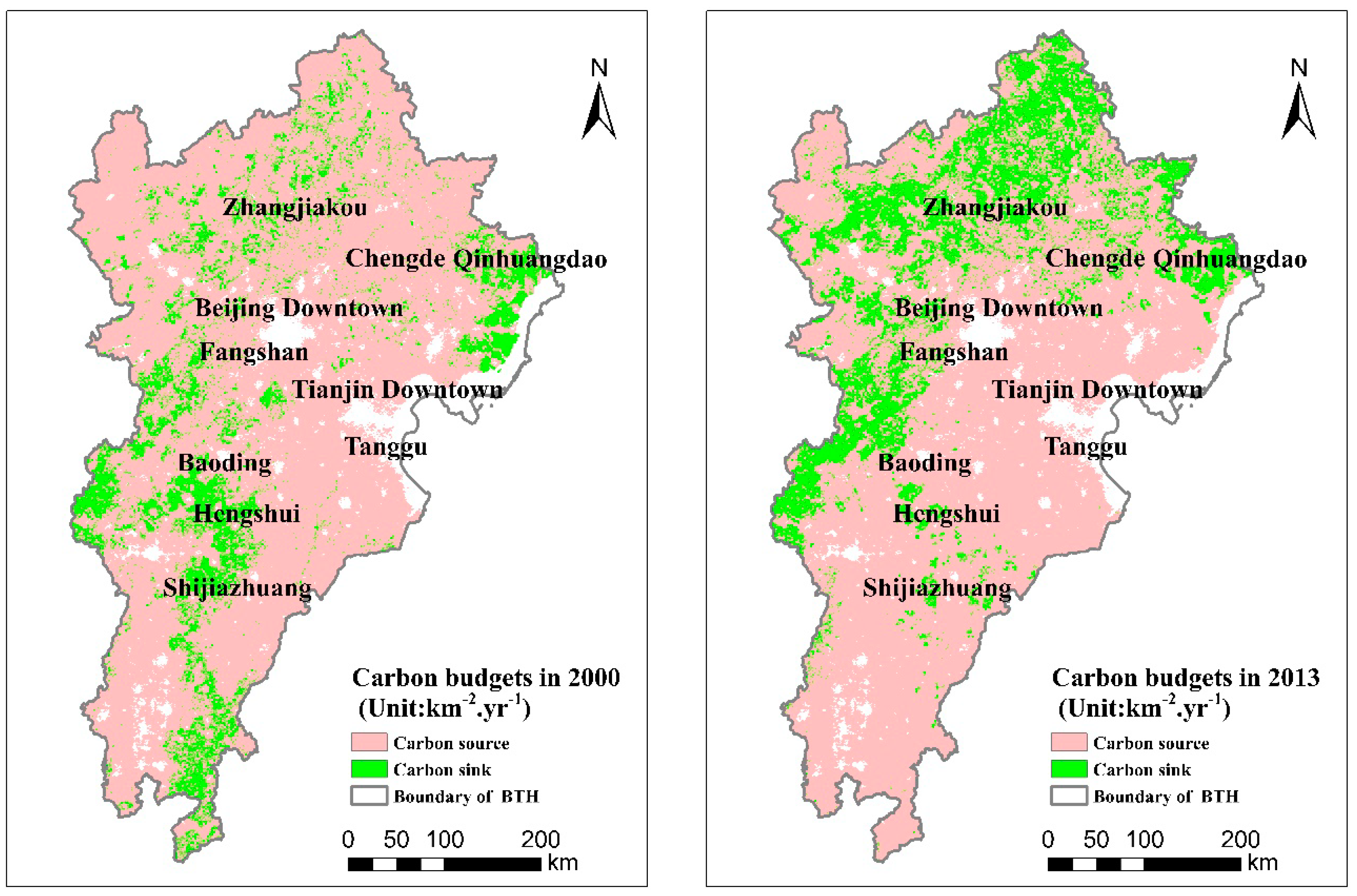
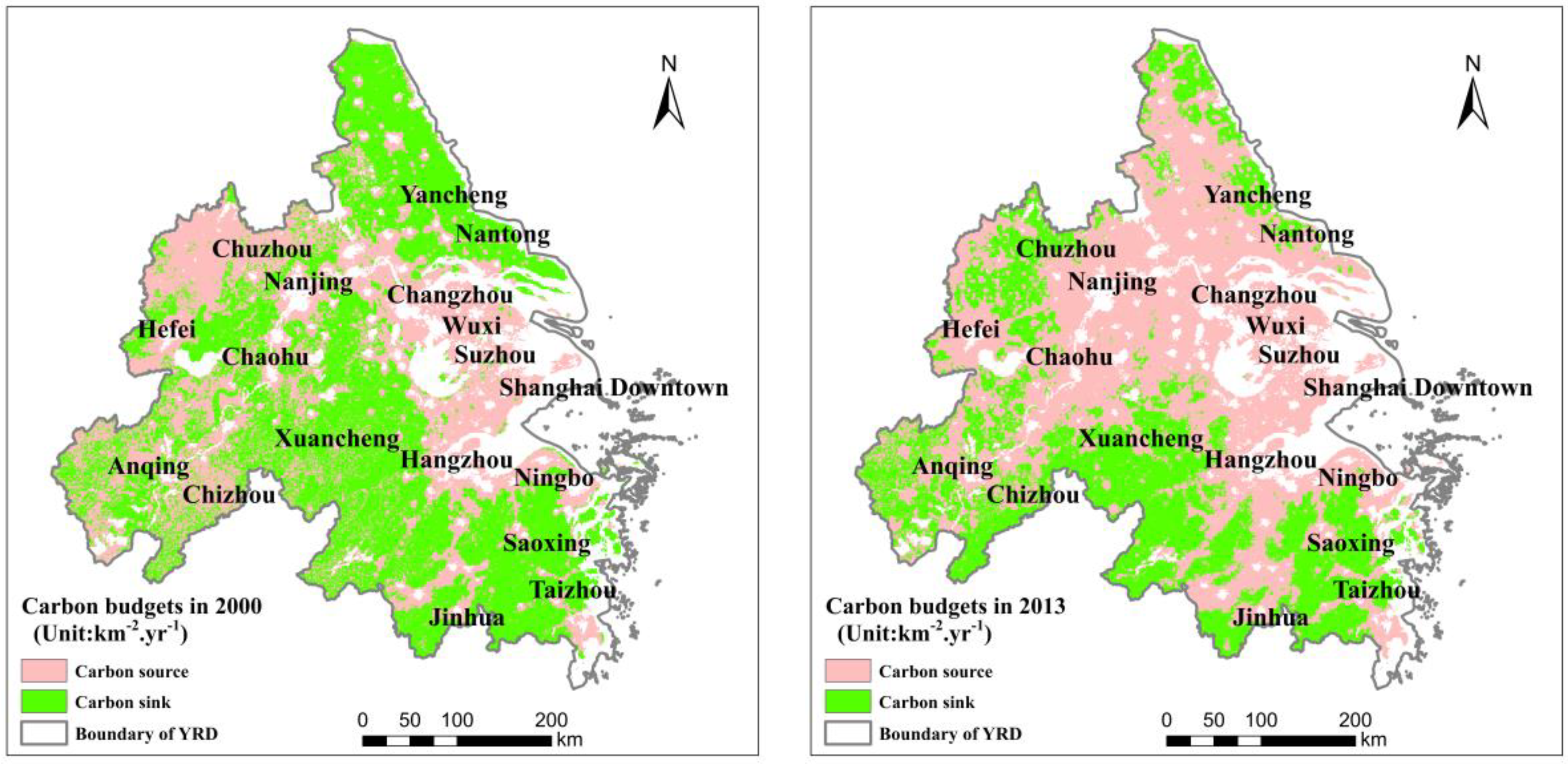
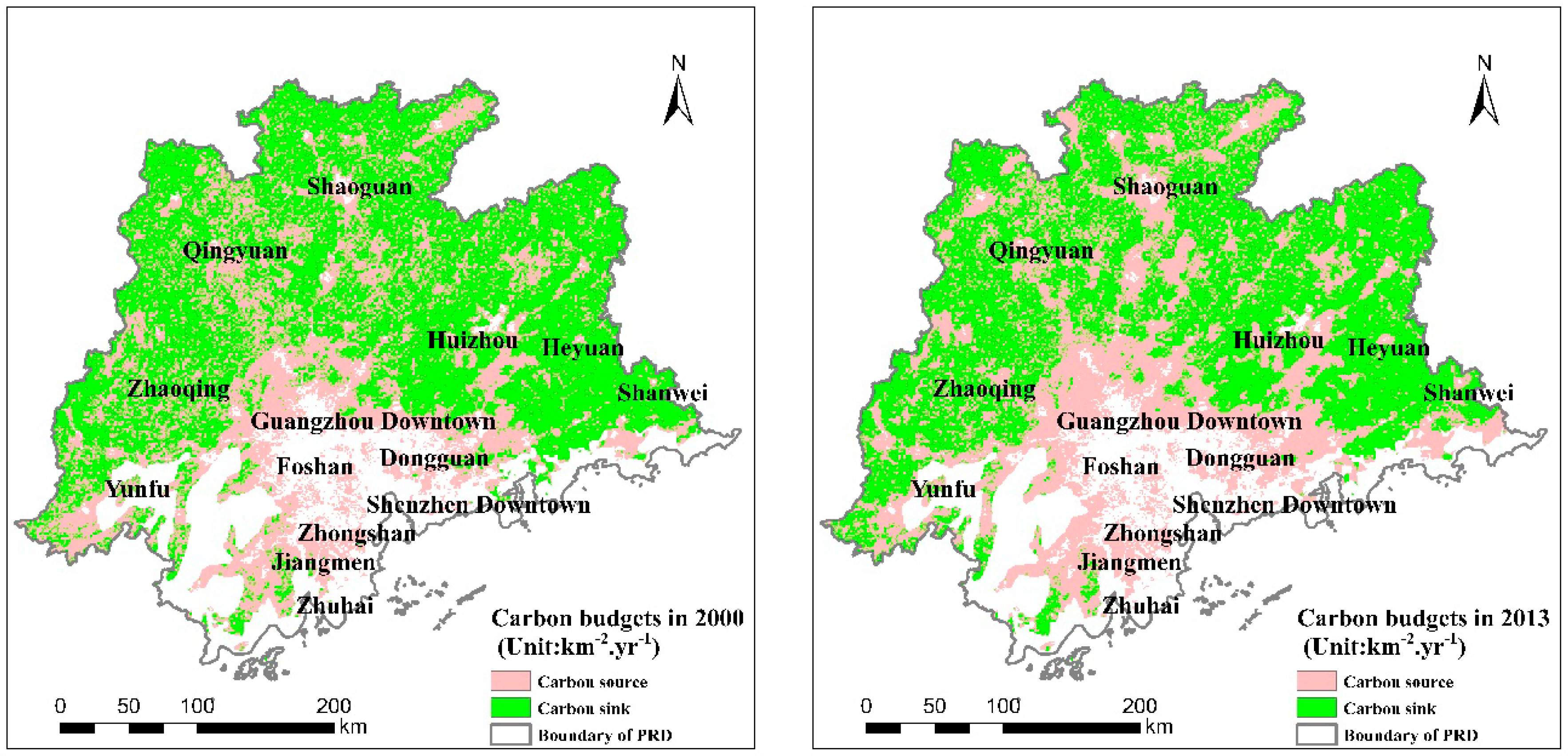
| Year | Beijing–Tianjin–Hebei (BTH) | Yangtze River Delta (YRD) | Pearl River Delta (PRD) | |||||||
|---|---|---|---|---|---|---|---|---|---|---|
| Mean | Std dev. | Moran’s I | Mean | Std dev. | Moran’s I | Mean | Std dev. | Moran’s I | ||
| NEP in the whole urban agglomeration (gC·m−2·year−1) | 2000 | −55.60 | 69.58 | 0.4934 | 93.89 | 149.57 | 0.5146 | 144.37 | 260.96 | 0.2511 |
| 2001 | −67.54 | 72.08 | 0.4797 | 183.11 | 157.13 | 0.5221 | 190.66 | 279.22 | 0.2840 | |
| 2002 | −28.18 | 74.55 | 0.4543 | 190.65 | 156.09 | 0.4995 | 158.89 | 261.69 | 0.2627 | |
| 2003 | 17.81 | 80.95 | 0.4629 | 133.76 | 169.50 | 0.5961 | 211.01 | 280.73 | 0.2563 | |
| 2004 | 60.22 | 79.57 | 0.4706 | 168.96 | 172.05 | 0.5799 | 261.87 | 302.11 | 0.2713 | |
| 2005 | −6.94 | 80.89 | 0.4387 | 94.85 | 166.80 | 0.5977 | 143.11 | 263.49 | 0.2408 | |
| 2006 | 6.31 | 76.55 | 0.4528 | 165.93 | 163.25 | 0.5418 | 169.50 | 272.06 | 0.2583 | |
| 2007 | −49.61 | 85.65 | 0.4824 | 160.23 | 175.59 | 0.5778 | 177.33 | 289.28 | 0.2716 | |
| 2008 | 17.09 | 83.23 | 0.4451 | 177.74 | 160.10 | 0.5168 | 161.17 | 287.09 | 0.2695 | |
| 2009 | −26.57 | 82.45 | 0.4373 | 128.76 | 167.13 | 0.5687 | 166.49 | 299.78 | 0.3142 | |
| 2010 | −40.76 | 78.51 | 0.5014 | 163.94 | 157.56 | 0.4697 | 164.00 | 275.04 | 0.2991 | |
| 2011 | −12.68 | 82.86 | 0.4579 | 118.85 | 158.94 | 0.5474 | 165.32 | 281.92 | 0.3023 | |
| 2012 | 14.60 | 81.75 | 0.4218 | 195.46 | 160.26 | 0.4826 | 184.98 | 272.35 | 0.2736 | |
| 2013 | −17.25 | 84.81 | 0.4291 | 163.53 | 164.50 | 0.5094 | 196.18 | 268.11 | 0.2551 | |
| NEP in built-up area (gC·m−2·year−1) | 2000 | −75.31 | 50.40 | 0.3441 | 5.20 | 136.84 | 0.3996 | 0.70 | 238.53 | 0.1643 |
| 2001 | −72.04 | 48.05 | 0.2465 | 60.56 | 154.25 | 0.4197 | −8.72 | 247.47 | 0.1816 | |
| 2002 | −42.79 | 50.75 | 0.2785 | 85.87 | 132.06 | 0.3791 | 1.90 | 238.23 | 0.2004 | |
| 2003 | −4.58 | 55.62 | 0.2480 | 34.46 | 143.34 | 0.4159 | 35.19 | 231.18 | 0.2271 | |
| 2004 | 18.52 | 64.48 | 0.2511 | 54.31 | 143.52 | 0.4190 | 13.49 | 235.24 | 0.3363 | |
| 2005 | −47.56 | 58.30 | 0.2682 | 3.19 | 129.37 | 0.3946 | −35.93 | 225.64 | 0.2018 | |
| 2006 | −47.68 | 58.95 | 0.2641 | 10.98 | 122.49 | 0.2706 | −24.27 | 225.92 | 0.1935 | |
| 2007 | −81.96 | 55.47 | 0.3276 | 17.19 | 130.62 | 0.3148 | 36.57 | 242.90 | 0.2439 | |
| 2008 | −25.25 | 60.68 | 0.3242 | 46.54 | 132.14 | 0.2474 | −15.68 | 235.54 | 0.3130 | |
| 2009 | −65.05 | 58.06 | 0.4171 | −0.94 | 130.04 | 0.2502 | −3.90 | 226.96 | 0.3085 | |
| 2010 | −78.75 | 52.92 | 0.3255 | 24.98 | 131.37 | 0.2479 | −17.86 | 227.23 | 0.3717 | |
| 2011 | −62.62 | 60.60 | 0.2913 | 5.32 | 125.06 | 0.3208 | −51.40 | 219.06 | 0.3129 | |
| 2012 | −37.00 | 62.96 | 0.2976 | 61.54 | 131.31 | 0.2793 | −76.95 | 205.48 | 0.2837 | |
| 2013 | −53.02 | 59.04 | 0.2317 | 33.05 | 124.41 | 0.2619 | −48.01 | 217.39 | 0.3123 | |
| Year | BTH | YRD | PRD | ||||||
|---|---|---|---|---|---|---|---|---|---|
| Mean | Std dev. | Moran’s I | Mean | Std dev. | Moran’s I | Mean | Std dev. | Moran’s I | |
| 2000 | 463.04 | 1442.78 | 0.9469 | 490.94 | 1367.93 | 0.6669 | 259.40 | 666.37 | 0.8523 |
| 2001 | 544.52 | 1505.50 | 0.9477 | 475.54 | 1173.07 | 0.6799 | 277.57 | 669.77 | 0.8546 |
| 2002 | 566.06 | 1482.58 | 0.9433 | 506.95 | 1089.18 | 0.6858 | 297.70 | 681.58 | 0.8706 |
| 2003 | 636.43 | 1550.60 | 0.9434 | 552.18 | 1056.89 | 0.7010 | 366.93 | 769.93 | 0.8606 |
| 2004 | 701.95 | 1637.05 | 0.9453 | 656.46 | 1228.02 | 0.7085 | 400.48 | 826.35 | 0.8601 |
| 2005 | 826.18 | 1895.50 | 0.9461 | 589.90 | 1082.93 | 0.7178 | 483.27 | 991.79 | 0.8609 |
| 2006 | 891.89 | 1945.32 | 0.9487 | 838.93 | 1447.07 | 0.7439 | 553.74 | 1106.91 | 0.8671 |
| 2007 | 982.72 | 2092.43 | 0.9482 | 929.47 | 1565.34 | 0.7424 | 611.72 | 1206.12 | 0.8692 |
| 2008 | 977.99 | 2023.76 | 0.9490 | 992.53 | 1622.94 | 0.7499 | 650.88 | 1265.79 | 0.8693 |
| 2009 | 1038.98 | 2105.40 | 0.9499 | 1044.97 | 1695.25 | 0.7501 | 693.79 | 1341.06 | 0.8693 |
| 2010 | 1085.69 | 2133.88 | 0.9513 | 1082.26 | 1669.76 | 0.7604 | 725.16 | 1372.46 | 0.8732 |
| 2011 | 1176.12 | 2261.82 | 0.9496 | 1128.70 | 1677.15 | 0.7531 | 762.40 | 1395.20 | 0.8681 |
| 2012 | 1215.77 | 2283.05 | 0.9497 | 1161.78 | 681.98 | 0.7523 | 778.47 | 1413.51 | 0.8687 |
| 2013 | 1307.46 | 2290.70 | 0.9488 | 1255.88 | 1718.91 | 0.7491 | 755.93 | 1306.51 | 0.8676 |
| Year | BTH | YRD | PRD | ||||||
|---|---|---|---|---|---|---|---|---|---|
| Mean | Std dev. | Moran’s I | Mean | Std dev. | Moran’s I | Mean | Std dev. | Moran’s I | |
| 2000 | −292.93 | 697.23 | 0.7417 | −121.39 | 631.51 | 0.3968 | 47.56 | 458.91 | 0.6916 |
| 2001 | −378.56 | 843.50 | 0.7226 | −52.72 | 640.53 | 0.4450 | 76.91 | 504.67 | 0.7106 |
| 2002 | −369.61 | 909.61 | 0.7712 | −100.28 | 716.32 | 0.4933 | 27.94 | 512.83 | 0.7357 |
| 2003 | −388.11 | 1030.01 | 0.7358 | −216.66 | 769.76 | 0.5269 | 29.09 | 612.82 | 0.7522 |
| 2004 | −401.20 | 1116.09 | 0.7489 | −253.63 | 901.76 | 0.5395 | 59.78 | 671.61 | 0.7629 |
| 2005 | −554.17 | 1301.45 | 0.8038 | −287.32 | 797.43 | 0.5468 | −102.03 | 746.42 | 0.7961 |
| 2006 | −600.73 | 1374.11 | 0.8175 | −395.27 | 1112.47 | 0.5986 | −119.06 | 837.92 | 0.8151 |
| 2007 | −724.38 | 1490.15 | 0.8185 | −470.81 | 1204.86 | 0.5941 | −146.48 | 902.69 | 0.8184 |
| 2008 | −663.78 | 1454.82 | 0.8221 | −509.84 | 1288.66 | 0.6137 | −189.19 | 954.62 | 0.8267 |
| 2009 | −758.61 | 1533.96 | 0.8264 | −597.94 | 1343.25 | 0.6133 | −208.97 | 1004.11 | 0.8302 |
| 2010 | −822.63 | 1611.03 | 0.8370 | −617.01 | 1396.82 | 0.6380 | −235.18 | 1032.73 | 0.8441 |
| 2011 | −871.29 | 1739.10 | 0.8348 | −713.79 | 1416.76 | 0.6244 | −270.96 | 1079.81 | 0.8448 |
| 2012 | −885.31 | 1780.58 | 0.7931 | −670.43 | 1437.13 | 0.6230 | −252.59 | 1030.91 | 0.8505 |
| 2013 | −1008.62 | 1792.54 | 0.7226 | −795.52 | 1483.99 | 0.6260 | −262.84 | 1105.34 | 0.8436 |
© 2019 by the authors. Licensee MDPI, Basel, Switzerland. This article is an open access article distributed under the terms and conditions of the Creative Commons Attribution (CC BY) license (http://creativecommons.org/licenses/by/4.0/).
Share and Cite
Wen, J.; Chuai, X.; Li, S.; Song, S.; Li, Y.; Wang, M.; Wu, S. Spatial Heterogeneity of the Carbon Emission Effect Resulting from Urban Expansion among Three Coastal Agglomerations in China. Sustainability 2019, 11, 4590. https://doi.org/10.3390/su11174590
Wen J, Chuai X, Li S, Song S, Li Y, Wang M, Wu S. Spatial Heterogeneity of the Carbon Emission Effect Resulting from Urban Expansion among Three Coastal Agglomerations in China. Sustainability. 2019; 11(17):4590. https://doi.org/10.3390/su11174590
Chicago/Turabian StyleWen, Jiqun, Xiaowei Chuai, Shanchi Li, Song Song, Yuanwei Li, Mengjie Wang, and Shuosheng Wu. 2019. "Spatial Heterogeneity of the Carbon Emission Effect Resulting from Urban Expansion among Three Coastal Agglomerations in China" Sustainability 11, no. 17: 4590. https://doi.org/10.3390/su11174590
APA StyleWen, J., Chuai, X., Li, S., Song, S., Li, Y., Wang, M., & Wu, S. (2019). Spatial Heterogeneity of the Carbon Emission Effect Resulting from Urban Expansion among Three Coastal Agglomerations in China. Sustainability, 11(17), 4590. https://doi.org/10.3390/su11174590






